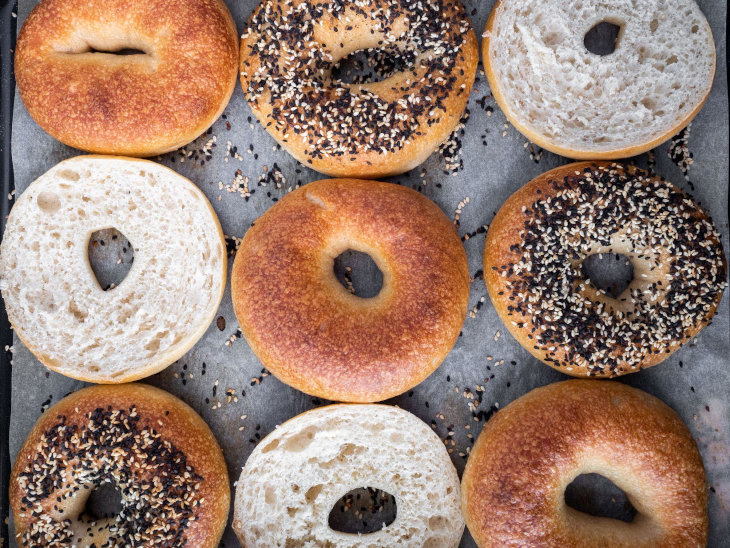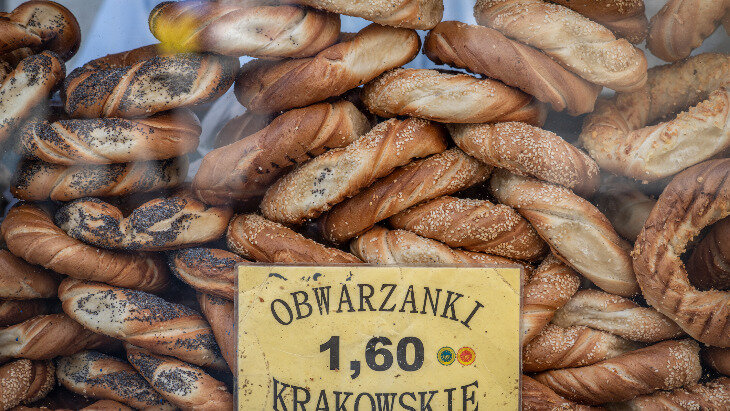You'd be hard-pressed to find a single Jew in the world who hasn't tried a bagel. But very few may know that bagels have a long history dating back to 17th century Poland, where they were called “Obwarzaneks.”
The Bagel’s Origins
To discuss the history of the bagel we need to go back hundreds of years to Krakow, Poland to learn the humble origins of the round, ring-shaped bread we are all so fond of today.
One of the earliest mentions of a Jewish circular bread, which are reminiscent of bagels, can be found in the Jewish community rules of Krakow in 1610 where it said that, "Bagels would be given as a gift to any woman in childbirth."
Because of their shape, with no beginning and no end, bagels symbolize the eternal circle of life. In the old country, there was a superstition that they were able to protect against demons and evil spirits, and have the power to ward off the evil eye. For these reasons, they were served at circumcisions and to women in labor. (On Rosh Hashanah, the Jewish New Year, we eat round challahs for similar reasons.)
Speaking of their shape, perhaps one of the most common questions asked about bagels is: what is the hole in the middle for? Well, the answer is more practical than aesthetical. Due to the density of bagel dough, it would be incredibly difficult to know if the bagel had been cooked all the way through without the hole in the middle. The hole also allows them to be piled high on a dowel, which makes them easy to transport and display.
Bagels in the Ghetto
In her book on the subject, The Bagel: The Surprising History of a Modest Bread, Maria Balinska writes, "In 1941 there were still functioning bakeries in the Warsaw Ghetto to fulfill the rations allotted to each Jewish inhabitant, but unofficially they baked other blackmailed goods with flour smuggled from the Aryan side."
Another Warsaw Ghetto diarist wrote of the food in the Ghetto, "The bread was dark and tasted of sawdust." Though the bagels in the Warsaw Ghetto weren't nearly as tasty as the ones found in bagel shops today, bagels played a crucial part in the survival of the Warsaw Jews in the darkest times of the Holocaust.
Bakeries in 19th and 20th century Poland seem to have served the same role that coffee shops did in other countries — they were places where young people in the Jewish community would gather to discuss new, radical political ideas, and likely where Mordechai Anilewiecz and his associates formed the secret underground organization "AYAL," which was the Jewish Fighting Organization responsible for the Warsaw Ghetto uprising.
The benefit of meeting in bakeries was that bakeries were inconspicuous places where you could meet with people from all walks of life who would go to the bakery regularly. So, stopping by to score a baker's dozen bagels wasn't seen as anything out of the ordinary.
In Pearl Benisch's testimony of her time in the Krakow Ghetto, she speaks of one charitable Jewish family who housed her during the harshest times of the Krakow Ghetto in 1942, called the Bagel family.
The Bagel family owned one of the main Jewish bakeries in Krakow at the time, and according to some are the namesake of our favorite Jewish bread.
When the Krakow Ghetto was founded, the Bagel's apartment, which was once a spacious home for the entire Bagel family, now housed all their relatives and friends in close quarters, because of the Nazi’s mandate. The apartment had close to 50 people eating and sleeping at the Bagel home each evening.
However, despite the limited space, they still invited all who were hungry to join them each evening. Providing to some their first nutritious meal that week, and for others their first meal in several weeks. They had their children working day and night, without rest, to smuggle as much bread and baked goods as they could get for the hungry Jews of the Ghetto. Pearl says of their bakery, "You could smell the aroma of freshly baked bread throughout the entire ghetto."
The Yom Kippur Bagels
In her testimony, Pearl mentions a powerful memory she had of the Bagel family:
It was Yom Kippur eve. The dining room was flooded with starving young men, eager to strengthen their bodies with a little food in preparation for the fast day. At a certain point, the Bagel family stopped baking and joined the rest of the family who was engaged in distributing soup and bread to the hungry. The day was coming to an end, but the waiting crowd grew stronger. “More soup, more food,” their eyes silently begged.
Just before the fast, the mother asked her children to eat something themselves, reminding them of the long fast ahead of them.
"Don't you notice what's going on here? They keep coming!" they responded. "There's no time to spare, hurry up and bring more soup or any other edible thing that's still in the house."
Finally, after the mother's persistence and hours of serving the hungry, the Bagel family reluctantly decided to come together for a meal before the fast and prepare for Yom Kippur, the Day of Judgement. The day that will decide their fates, and the fates of all those in the Krakow Ghetto.
The story of the bagel is a lesson in the importance of food to our culture. Each bagel is full of Jewish history and tradition which makes it so much more than a round bread with a hole in the middle. And to fully understand the impact the bagel has had on our history and culture, is to begin to learn to appreciate the bagel in its full capacity.
Want to make your own bagels? Get our recipe here.
















